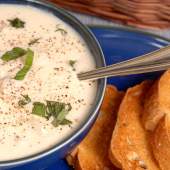Three Condiments

“Americans will eat garbage provided you sprinkle it liberally with ketchup.”
--Henry James
“I mix mayonnaise, ketchup, and brandy with a little bit of mustard. This is a heck of a good sauce for seafood.”
--José Andres
“The Japanese have become so smitten with the Western condiment…that today they have a word for mayonnaise junkie: mayora.”
--Tom Robbins
From the very beginning of food consumption, humans have been on a quest to make it taste better. So, after the addition of simple salt or sugar left them unsatisfied, the use of condiments has been the way to go, while also providing a way to challenge the autonomy of the chef by altering a dish to the diner’s personal taste.
The term “condiment” is Latin in origin – from condimentum, which means “spice, seasoning, or sauce.” Generally, anything referred to as a condiment must have liquid involved in it (distinguishing it from a spice), and be viable for a long period of time. This certainly applied to a staple of the ancient Greeks and Romans: fish sauce, made by pulverizing fish parts into a paste and fermenting them in salt with vinegar. (It might not sound so appetizing to a Western palate, perhaps, but it is still popular and is a common ingredient in many East Asian recipes.) Just as you would expect to see soy sauce in a Chinese restaurant, gochujang in a Korean place, and olive oil when dining Italiano, fish sauce was a fixture on every Roman table, and also an ingredient in many dishes. So perhaps it’s not surprising that it was also the basis for at least some of the condiments we love today. Here are three of them…
Ketchup – We wouldn’t tend to associate ketchup, an essential condiment that more than 95% of Americans have in their refrigerator or on their dinner table, with fish. But its name is derived from the Hokkien Chinese term kê-tsiap, a sauce made from fermented fish that is believed to have originated in Vietnam. As you might imagine, it didn’t remotely resemble ketchup as we know it today – early versions were chock full of ingredients such as oysters, walnuts, anchovies, or mushrooms (Jane Austen is said to have been a fan of the last variety). In 1812, horticulturalist James Pease came up with a version that incorporated his beloved “love apples,” and tomatoes finally landed squarely where they belonged, in a “paste” that also included brandy and spices. Later, sugar and vinegar were added, and once Pittsburgh native Henry J. Heinz started mass-producing ketchup in 1876, this culinary mainstay never looked back.
Mustard – Need a glaze for your spit-roasted boar? The ancient Romans did, and that’s when the first recipe for mustard appeared. (The name is derived from mustum ardens, meaning “burning must,” which is not very enlightening, except that it tells us that the first mustards were originally very spicy.) To make it, grape juice was combined with ground mustard seeds, the ever-popular fish sauce, oil, honey, and most of the contents of your kitchen spice rack. Welcome to 500 AD! By the 13th century, Dijon, France was becoming (and still is) a major center for mustard manufacturers, and hit the big time once its most famous product, Grey-Poupon, was introduced in 1777. French’s familiar bright yellow mustard (not created in France, but by an American man named Robert Timothy French) made its splashy entrance onto hot dogs at that seminal event in American culinary history, the 1904 World’s Fair in St. Louis. By the way, its bright yellow color comes not from mustard seed, but from turmeric.
Mayonnaise – Given how ubiquitous it is, it’s surprising that mayonnaise is, reputedly, a comparatively late addition to the condiment club, at least compared with ketchup and mustard. America’s biggest mayonnaise manufacturer Hellman’s explains its origins: “Mayonnaise is said to be the invention of the French chef of the Duke de Richelieu in 1756. While the Duke was defeating the British at Port Mahon [now on the island of Minorca], his chef was creating a victory feast that included a sauce made of cream and eggs. When the chef realized that there was no cream in the kitchen, he improvised, substituting olive oil for the cream. A new culinary masterpiece was born and the chef named it ‘Mahonnaise’ in honour of the Duke’s victory.” Some food experts have been downright derisive of this story, saying that experiments with oil, garlic, and salt had been going on for centuries until someone got the idea to add eggs and an acid such as vinegar or lemon juice to the mixture. Regardless of which story is true, mayonnaise is quite simple to make, and an integral component in sandwiches everywhere.
Other popular condiments (if you don’t count sauces, which will be covered in a future story) include salsa, sour cream, and horseradish. We don’t recommend using all of these on the same dish, but it’s your stomach!





